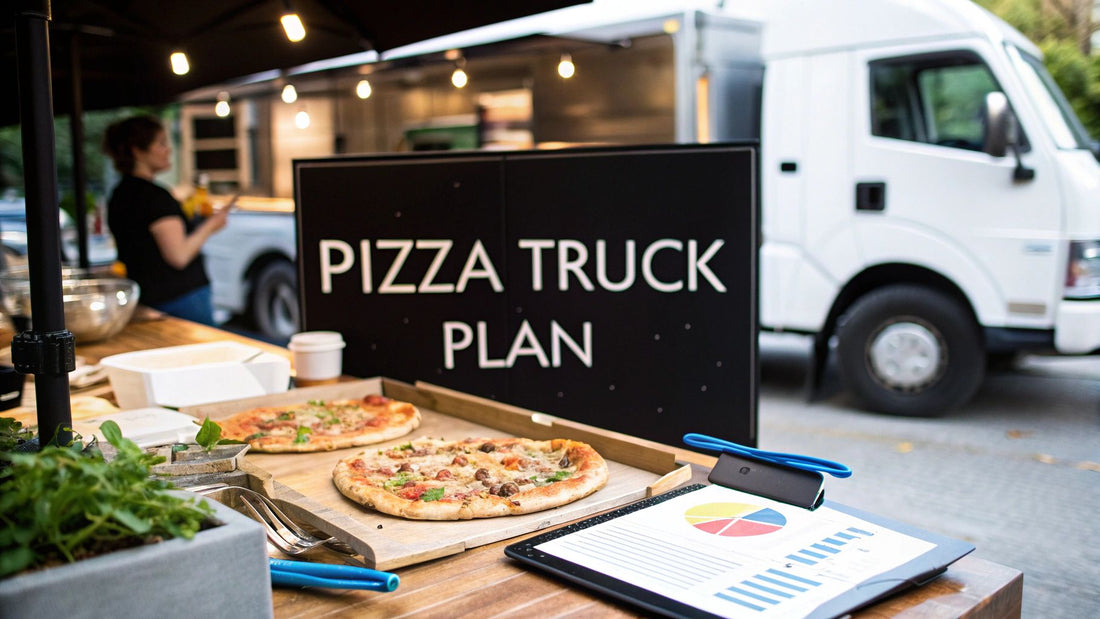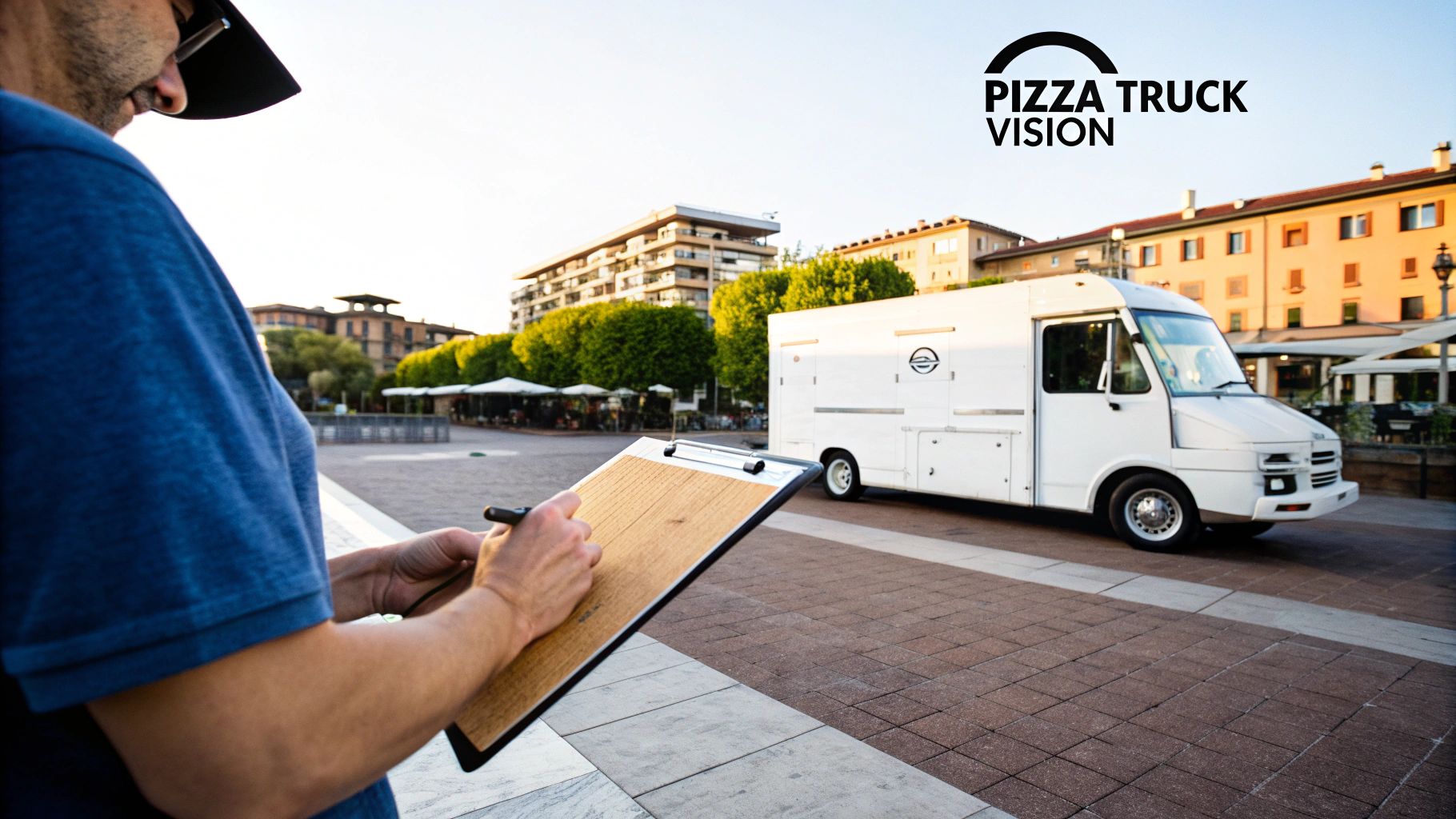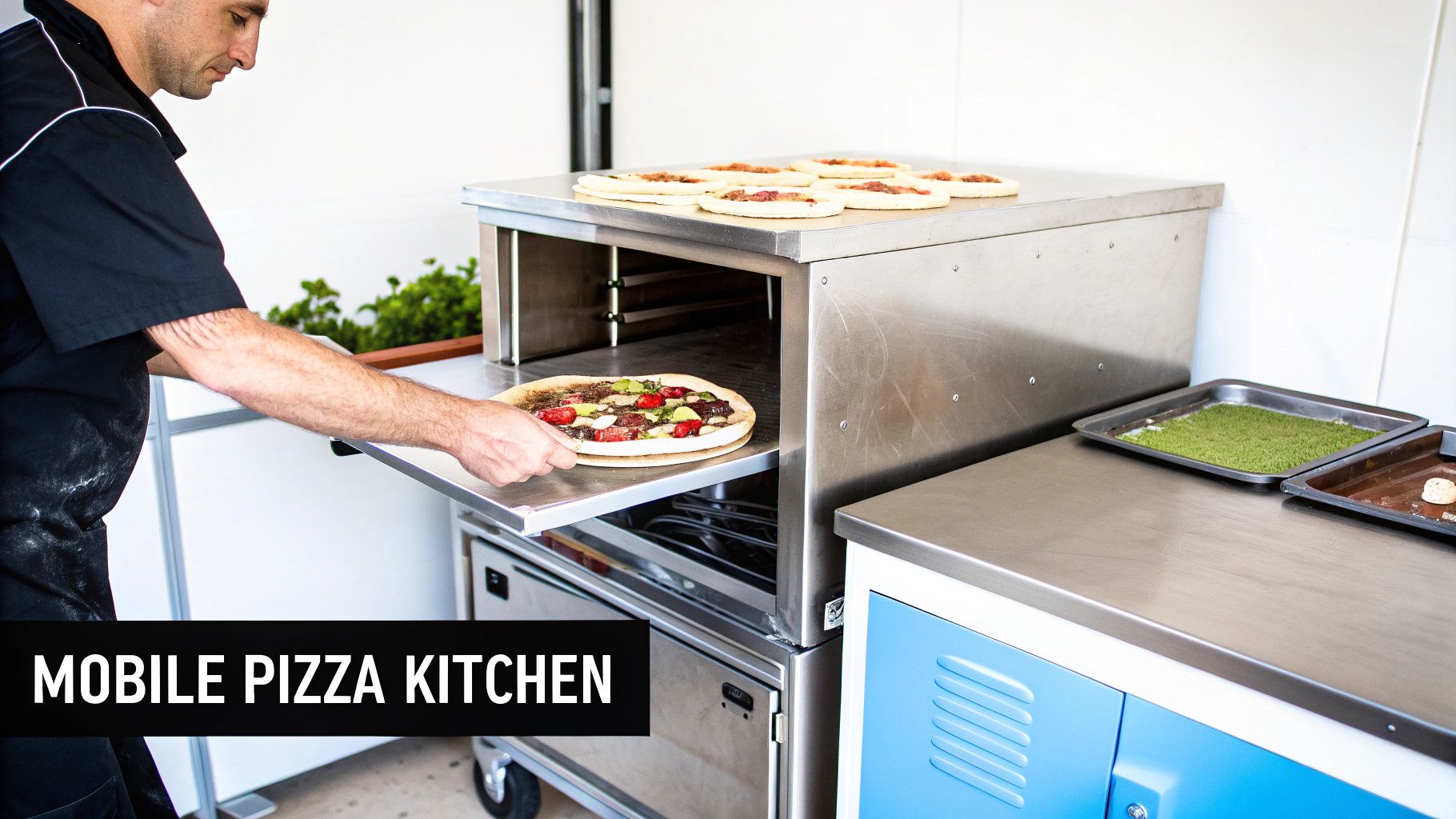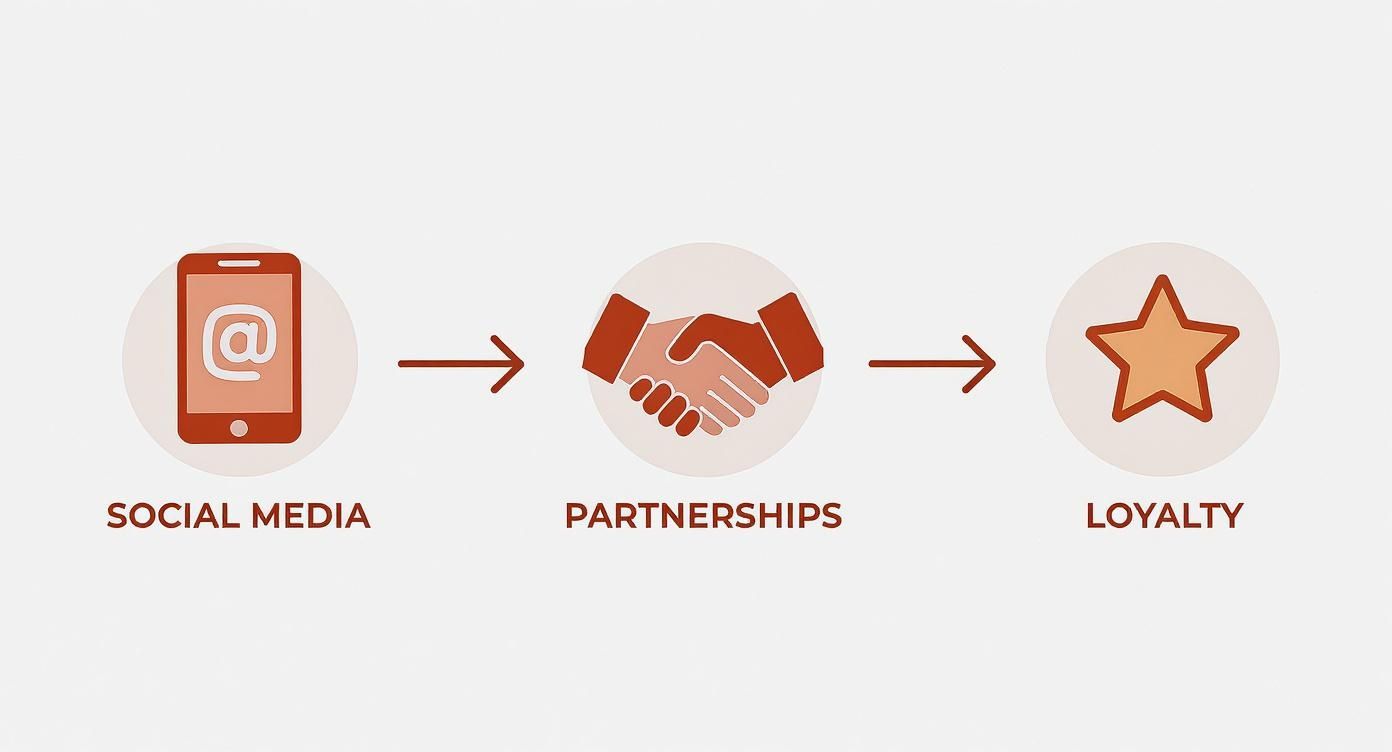
A Winning Pizza Food Truck Business Plan Template
Share
A solid food truck business plan template is your roadmap. It’s what turns your big idea for a pizza restaurant on wheels into a real, step-by-step plan that takes you from a concept scribbled on a napkin all the way to your grand opening. This is the document that forces you to figure out everything from menu pricing to your marketing strategy, making sure your mobile pizzeria is actually built to last.
Crafting Your Pizza Truck Vision and Mission

Starting a pizza food truck is about so much more than a killer recipe—you're building a brand from the ground up. This is where you move past generic templates and start creating a plan that truly captures the unique vibe of your mobile pizza restaurant.
Your vision statement is the big picture, the "why" that gets you out of bed in the morning. Think of it as your ultimate goal. For instance, your vision might be "To become the most beloved mobile pizzeria in the downtown core, known for authentic Neapolitan-style pizza." It should feel ambitious and get you excited.
The mission statement, on the other hand, gets down to the "how." It’s a practical statement explaining what you do, who you're serving, and what makes you different from every other pizza place out there.
A clear mission statement acts as a compass for your daily operations. It guides menu development, customer service standards, and even the design of your pizza prep table layout for maximum efficiency.
Defining Your Core Concept
Before you write a single word of your plan, you need to nail down the soul of your pizza truck. What’s the story here? This goes way beyond just listing toppings and gets to the heart of what your pizza restaurant is all about.
Here are a few things to chew on:
- Your Pizza's Story: Are you using a secret family sauce recipe passed down for generations? Do you get all your mozzarella from a dairy just outside of town? Your story is your most powerful marketing tool, so don't be afraid to lean into it.
- Target Audience: Are you chasing the lunchtime office crowd that needs something quick and easy? Or are you parking near the bars to catch the late-night scene? Who you're selling to changes everything—your menu, your prices, and where you park.
- Unique Selling Proposition (USP): Get specific about what makes you stand out. Is it your 72-hour fermented sourdough crust? Your commitment to using only vegan ingredients? Maybe it’s your blistering 90-second cook times, enabled by a high-tech oven and an ultra-efficient pizza prep table, that get people fed and on their way.
Setting Measurable First-Year Goals
Once you have your vision, it's time to set some real, achievable goals. Vague ideas like "sell a lot of pizza" won't impress an investor and won't give you anything to aim for. You need to focus on specific numbers that spell out what success looks like for your pizza restaurant in its first year.
For example, instead of a fuzzy goal, get concrete: "Sell 100 pizzas per day within the first six months."
Other measurable goals could be:
- Secure three regular weekly spots at high-traffic locations.
- Achieve a 30% profit margin on your signature Margherita pizza.
- Book 12 private catering events or festival appearances.
This kind of strategic thinking is crucial, especially now. The global food truck industry was valued at around USD 5.8 billion in 2025 and is set to grow even more, which tells you there’s a huge appetite for mobile food. You can explore more about these market projections and see just how strong the business case for your new venture really is.
Analyzing Your Market and Defining Your Niche
A killer pizza recipe is a great start, but it's only half the battle. Success in the pizza restaurant game is won on the streets—by knowing your turf and exactly who you're selling to. This section of your food truck business plan template is where you stop guessing and start strategizing.
First up, who are you feeding? Don't just say "everyone." Are you targeting the downtown lunch crowd that needs a high-quality slice in under ten minutes? Or are you aiming for families chilling at suburban parks on a Saturday afternoon? Knowing your ideal customer dictates everything: your menu, your pricing, and even the layout of your kitchen around the pizza prep table.
Next, you’ve got to size up the competition. This isn’t a quick Google search. Get out there and spend a few afternoons scouting your target areas. Visit other mobile pizzerias and even the popular brick-and-mortar pizza restaurants. Take notes. How much are they charging? How fast is their service? What are people lining up for?
Pinpointing Your Unique Selling Proposition
Once you have the lay of the land, it’s time to figure out what makes your pizza truck unforgettable. This is your Unique Selling Proposition (USP), and it needs to be laser-focused. It’s the one compelling reason a hungry customer walks over to your truck instead of another pizza place.
Think about what truly sets you apart:
- Dough and Ingredients: Maybe you use a 72-hour fermented sourdough that’s impossible to replicate. Or perhaps all your toppings are sourced from local farms within a 50-mile radius.
- Specialty Options: Are you the only pizza restaurant in town with a full menu of vegan cheese and plant-based pepperoni? That's a powerful niche.
- Speed and Convenience: With a slick layout and an efficient pizza prep table, maybe your promise is a perfectly blistered pizza in under five minutes flat.
Your USP becomes the heartbeat of your brand. It’s what you’ll shout about on Instagram and what your happy customers will tell their friends.
Your USP isn't just a marketing slogan; it's an operational commitment. If your claim is lightning-fast service, every piece of equipment, from your oven to your pizza prep table, must be chosen to deliver on that promise.
Conducting a SWOT Analysis for Your Pizza Truck
A SWOT analysis (Strengths, Weaknesses, Opportunities, Threats) is a simple but powerful way to look at your pizza restaurant from every angle. It helps you see challenges coming and grab opportunities before your competitors even notice them. For a pizza food truck, this framework is incredibly useful.
| Category | Description & Pizza Truck Examples |
|---|---|
| Strengths | Internal advantages you can control. Example: A secret family sauce recipe, a high-efficiency oven that cooks in 90 seconds, or a prime, secured parking spot at a busy brewery. |
| Weaknesses | Internal limitations you need to manage. Example: Limited onboard storage space, higher fuel costs due to a heavy truck, or relying on a single key employee (you!). |
| Opportunities | External factors you can jump on. Example: A new office park opening nearby, a popular local brewery without a food partner, or the explosion of weekend farmers' markets in your city. |
| Threats | External challenges you need to watch out for. Example: Fluctuating cheese and flour prices, new city regulations on mobile vendors, or another pizza truck launching in your primary zone. |
Understanding these factors is critical. For instance, knowing that local regulations are a potential threat will push you to stay ahead of the curve. Being proactive turns potential nightmares into manageable tasks for your mobile pizza restaurant.
Designing an Efficient Mobile Pizza Kitchen

This is where your food truck business plan template gets real. Forget the spreadsheets for a moment and think about steel, fire, and dough. An efficient mobile pizza restaurant is so much more than a collection of equipment; it's a tightly choreographed dance designed for speed and safety in a space smaller than most people's closets.
Workflow is king here. Walk through the life of one pizza, from a simple ball of dough to a masterpiece in a box. Every step needs to flow seamlessly into the next, cutting out every wasted motion. The classic layout is a logical path: from refrigeration to the pizza prep table, over to the oven, and finally to a cutting and boxing station right by the service window.
Choosing Your Pizza Oven
The oven is the heart and soul of your truck. It’s the single piece of equipment that defines your cooking style, your fuel budget, and the final taste and texture of your pizza. There’s no "best" oven—only the right one for your pizza restaurant concept.
- Wood-Fired Ovens: Nothing beats the flavor and marketing pull of a real wood-fired oven. It screams authenticity. But be ready for a steep learning curve, longer preheat times, and the constant need to manage your fire.
- Gas Deck Ovens: These are the workhorses of the mobile pizza world for a reason. They deliver consistent, controllable heat and are far easier to operate and maintain than wood-fired options, making them a solid choice for high-volume service.
- Conveyor Ovens: If your game is pure speed and consistency, nothing touches a conveyor oven. You sacrifice some of that artisanal charm, but you gain the ability to crank out perfectly uniform pizzas with minimal staff training. It's an ideal choice for massive events and festivals.
The Critical Role of the Pizza Prep Table
While the oven gets all the glory, the pizza prep table is the unsung hero that truly dictates your speed. This is where you win or lose the battle against the clock. A bad pizza prep table creates bottlenecks, risks food safety, and brings your entire operation to a grinding halt.
A great pizza prep table is a self-contained workstation, combining refrigerated ingredient wells up top with under-counter cold storage below. This keeps your cheese, sauce, and toppings perfectly chilled and literally at your fingertips. The goal is simple: your pizzaiolo should be able to build an entire pizza without taking more than a single step. For a deeper look at kitting out your truck, our comprehensive guide to [https://pizzapreptable.com] can get you started.
As you map out your kitchen, looking into dedicated food truck solutions can also give you a leg up on the operational tools and tech that make daily life on the road so much easier.
A well-organized pizza prep table is the difference between serving 15 pizzas an hour and serving 50. Every second saved during prep translates directly into higher revenue for your pizza restaurant during a busy lunch rush.
Space is your most valuable—and limited—asset. When selecting a pizza prep table, you're balancing prep surface area with cold storage capacity. Here's a quick comparison of two common types to help you decide.
Pizza Prep Table Feature Comparison
| Feature | Standard Refrigerated Prep Table | Mega Top Prep Table |
|---|---|---|
| Pan Capacity | Fewer, larger pans (e.g., 6 x 1/3 size) | More, smaller pans (e.g., 9 x 1/6 size) |
| Best For | Simple menus with core, high-volume toppings. | Complex menus with lots of specialty toppings. |
| Prep Space | Deeper cutting board, more room for dough. | Shallower cutting board to fit extra pan rows. |
| Food Truck Fit | Excellent for speed on a focused menu. | Good for gourmet concepts but can feel cramped. |
Ultimately, your menu dictates your choice. If you're slinging classic pepperoni pies all day, a standard pizza prep table's larger pans and deeper workspace are ideal. If you're a gourmet pizza restaurant with a dozen artisanal toppings, the extra pan capacity of a mega top might be worth sacrificing a bit of prep depth.
Staffing Your Mobile Pizzeria
Your team is every bit as crucial as your equipment. In the tight quarters of a food truck, clear roles are non-negotiable if you want to avoid chaos. Even with a tiny crew of two or three, everyone needs to own their station and know their responsibilities inside and out.
A typical pizza truck crew looks something like this:
- Pizzaiolo/Oven Operator: This is your star player, responsible for stretching dough, topping pies at the pizza prep table, and managing the all-important oven. It's usually your most skilled position.
- Cashier/Window Staff: This person is the face of your pizza restaurant. They take orders, handle payments, and box up the finished pizzas.
- Prep/Support: During a serious rush, a third person is a lifesaver. They can handle restocking the pizza prep table, pre-stretching dough, and jumping in wherever needed.
When you detail these roles in your business plan, you're showing potential investors that you’ve actually thought through the real-world logistics of running a smooth and profitable pizza restaurant from the very first day.
Creating Your Marketing and Sales Strategy
Even the most incredible pizza won't sell itself if no one knows your pizza restaurant exists. Your marketing and sales strategy is the megaphone for your mobile business, turning curiosity into a loyal, paying following. This is the part of your food truck business plan template where you map out exactly how you'll create a buzz and keep customers lining up for another slice.
Think of your truck as a rolling billboard—it's your most powerful marketing tool. But your digital presence is what tells people where that billboard is going to be parked. For food trucks, Instagram is your best friend. It’s built for showing off drool-worthy photos of pizzas fresh out of the oven or action shots of your perfectly organized pizza prep table. More importantly, it’s how you’ll shout out your daily location, turning a follower’s curiosity into a definite lunch plan.
Local Marketing and Smart Partnerships
Social media is crucial, but on-the-ground success is built by pounding the pavement. Guerilla marketing tactics work wonders for a mobile pizza restaurant. This is all about actively seeking out partnerships with local businesses that already have a built-in audience of hungry people.
You need to think about where your ideal customers gather. Consider these high-impact collaborations:
- Office Parks and Co-working Spaces: Get in touch with property managers and pitch your pizza restaurant as the official "Pizza Tuesday" lunch option.
- Apartment Complexes: Partner with residential buildings for a "no-cook Friday" event. You bring dinner right to their doorstep, and they get an easy, delicious meal.
- Breweries and Wineries: This is a goldmine. Many breweries don't serve food and are desperate for reliable partners. A fresh slice of your pizza is the perfect companion to a craft beer.
- Local Event Organizers: Get on the vendor list for every festival, farmers' market, and community gathering you can. This is how you tap into massive foot traffic.
This market is booming, and there's plenty of room for new players who are smart about where they park. The U.S. food truck industry hit a revenue of about USD 2.8 billion in 2025, growing at an impressive 13.2% annualized rate over the five years prior. That kind of rapid expansion signals a massive opportunity if you can place your pizza restaurant in front of the right customers. You can read the full research about food truck industry growth to see exactly how your pizza truck can tap into this demand.
Pricing Your Menu for Profitability
Setting the right price for your pizza is a delicate dance. You have to cover your ingredients, pay yourself, and turn a profit, all without making people think twice. Your pricing strategy needs to be a calculated decision, not just a gut feeling.
Your menu prices communicate your pizza restaurant's value. Price too low, and people might question your quality. Price too high, and you could scare off your target market before they even take a bite.
Start by calculating your "cost of goods sold" (COGS) for every pizza on the menu. That means adding up the cost of the dough, sauce, cheese, and every single topping. A solid industry benchmark to aim for is a food cost of around 25-30% of your menu price.
From there, you have to factor in what your competitors are charging and what makes you unique. If you're using premium, locally sourced ingredients, you can absolutely justify a higher price point than a truck using standard bulk supplies.
Finally, think about building loyalty from day one. Simple things like punch cards ("buy nine slices, get the tenth free") or setting up a basic online ordering system can turn first-time visitors into die-hard fans who actively hunt your pizza restaurant down.
Building Your Financial Projections
Alright, let's talk numbers. This is where the rubber meets the road for your pizza truck dream. The financial section of your food truck business plan template is where you move past the passion for pizza and lay out a realistic, data-driven roadmap. It’s how you prove to investors—and more importantly, to yourself—that this mobile pizza restaurant can actually be a profitable business.
First up is forecasting your sales. This isn't just guesswork; it's a calculated estimate. Start with your average ticket price. Are you slinging single slices for $5 a pop, or will most of your customers be families grabbing a whole pie and a few drinks for $30? Once you have a handle on that, you can start projecting customer volume for different scenarios, like a frantic downtown lunch rush versus a more relaxed weekend farmers' market.
Breaking Down Your Startup Costs
Before you can even think about serving that first slice, you're going to face a handful of one-time costs. Nailing these numbers down is absolutely critical for figuring out how much funding you actually need. This goes way beyond just the truck; it’s every single expense required to get your service window open for business on day one.
Your big-ticket startup investments will almost always include:
- The Truck and Build-Out: This is the big one. It covers the vehicle itself plus the custom kitchen conversion—think plumbing, electrical, and a proper ventilation system.
- Kitchen Equipment: Your oven is a major expense, but don't overlook your pizza prep table. It's the engine of your operation. Then there are refrigerators, mixers, and all the smaller wares.
- Initial Inventory: This is your first major stock-up of flour, cheese, sauce ingredients, toppings, and, of course, pizza boxes.
- Licenses and Permits: The fees for business registration, health permits, and vehicle licensing can add up faster than you'd think.
For a really detailed look at what to expect, a complete restaurant startup costs breakdown will help you budget for every last expense.

This process shows that successful marketing isn't a one-and-done deal. It’s a continuous cycle where each stage feeds the next, helping you build a loyal following that keeps your pizza restaurant thriving.
The Three Essential Financial Statements
With your costs and sales forecasts in hand, it’s time to build the three core financial statements. Any lender or investor worth their salt is going to demand these. Think of them as your financial compass, guiding your pizza restaurant's decisions long after you've hit the streets.
- Profit and Loss (P&L) Statement: This document projects your revenue, costs, and ultimate profitability over a set period, usually your first three years.
- Cash Flow Statement: This tracks the actual cash moving in and out of your business. It’s crucial for making sure you have the money on hand to pay suppliers and your team on time.
- Balance Sheet: This gives a snapshot of your business's financial health at a specific moment, listing what you own (assets like the truck and your pizza prep table) and what you owe (liabilities like a loan).
The food truck world is constantly changing. Market projections show some serious growth, jumping from USD 4.04 billion in 2024 to an expected USD 5.77 billion by 2029. This boom is fueled by trends like online ordering and contactless payments, which will directly impact your own revenue and cost models.
Your financial projections aren't just for securing a loan. They are a powerful management tool. They help you calculate your break-even point—the exact number of pizzas you need to sell each month just to cover your costs. Knowing this number for your pizza restaurant is incredibly empowering.
Your Pizza Food Truck Business Plan Questions, Answered
Got a few lingering questions about putting together your food truck business plan template? You’re definitely not alone. Let's tackle some of the most common hurdles I see aspiring pizza restaurant owners face, from getting funding to dealing with the endless local permits.
How Much Detail Should I Go Into for Equipment?
Get specific. Really specific. This is especially true for the heart of your operation, like your pizza oven and your pizza prep table.
Instead of just jotting down "refrigerated prep table," you need to detail the make and model. For example, a "60-inch, two-door pizza prep table with a 9-pan capacity." Then, explain why it's the right tool for the job. This level of detail shows lenders and investors that you've actually thought through the day-to-day grind of your pizza restaurant.
Explaining that your chosen pizza prep table keeps every topping within arm's reach proves you understand how to shave seconds off each order during a chaotic lunch rush. That’s the kind of operational thinking that gets people to write checks.
Can I Just Use a General Food Truck Template for a Pizza Truck?
A general template is a decent place to start, but you'll have to tear it apart and rebuild it for your pizza restaurant concept. A pizza-centric plan has unique needs that a generic plan will completely miss.
Think about it:
- Your Oven is Your Brand: The choice between a classic wood-fired oven and a high-efficiency gas deck oven completely changes your fuel costs, cook times, and even the story you tell your customers.
- Dough is Everything: Your plan needs to get into the nitty-gritty of your dough mixer, proofer, and refrigeration workflow. Your pizza prep table must accommodate this process.
- Supplier Relationships: Who are you getting your flour, cheese, and specialty tomatoes from? List your sources, especially for these high-volume items for your pizza restaurant.
If you want to see what a complete, general plan looks like before you add your pizza-specific details, this food truck business plan sample from GrowthGrid is a useful reference for the overall structure.
What’s the Most Overlooked Section in a Food Truck Plan?
Hands down, it's the "Operations" section. So many entrepreneurs get excited about the menu and the brand but completely gloss over the daily mechanics. Your plan needs to clearly map out the entire process of making and serving a pizza, from stretching the dough at the pizza prep table to handing the box to a customer.
This operational map is non-negotiable. It proves you've thought through the workflow in an incredibly tight space. It shows you’ve designed your layout—especially your pizza prep table station—for maximum speed and minimum chaos when there’s a line down the block.
Ready to build the heart of your mobile kitchen? At Pizza Prep Table, we provide the high-quality, durable prep stations that power successful pizzerias on wheels. https://pizzapreptable.com
